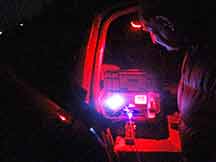

I'm coming to suspect that the tight confidence limits on so many new predictions in OW, are too optimistic. Odds of a "miss" were 28%, but that appears to be what I saw.
This is a very narrow track, only a couple miles wide. If the confidence limits on the path are valid, there's very little chance from Karl's place, and not much from Kirk's home or my home either. But at the bike crossing of UCSC the odds are 50%, and at my claimed site on Mill St across from DeLaveaga Park, I'm on the centerline.
Alt=52 in Az 255 in the WSW. This is a good direction from this spot on Mill St which I've used before. It's also good for the east side of the bike trail crossing at upper meadow UCSC.
The duration is 0.7 seconds so don't integrate more than necessary. Best not to over-integrate just to get a strong signal since it won't be gone for long and FP test is best passed with more points inside the occultation, even if noisy.
 |
 |
I'm coming to suspect that the tight confidence limits on so many new predictions in OW, are too optimistic. Odds of a "miss" were 28%, but that appears to be what I saw. |
We had thin cirrus in the sky, but seemed clear enough at my place to justify driving to the centerline at Mill St, on the ranch driveway corner as I've used a couple times in the past. It was cold, damp, but clear enough to see the target. 2-star align and GoTo went smoothly (Polaris and Rigel used). I hoped to use 8x or if clear even 4x. But in fact, the low thick crescent moon behind thicker clouds caused enough extinction and contrast loss that I felt I needed to use 16x setting. I was able to follow the target through the 2 minutes of recording.
The nominal prediction promised 72% odds of a "hit", with up to 3 integrations at ~zero. Instead it looks like a miss. There is no hint of any dip that could be tested for significance, so I will report a "miss" but qualify that a very short event could be buried in a sub frame within an integration.
 |
 |
 |
 |
 |
 |
 |
 |
Long 122 00 22.28"
Lat 36 59 57.76"
elev 114ft
The clouds gradually got thinner as the 2.2 minutes of recording progressed. The clouds were very thin and also fairly uniform, so far as I could tell by eye and by light curves. This aided detectability. The star should have completely disappeared, but never did. I used the TME aperture method in PyMovie, which found 10px as the best tight mask aperture, based on a 333 frame Fourier finder. Tracking was stable. I used Ref1 and Ref2 as reference star comparisons and also as tracking stars, with the closer one to the target being the primary tracking star. I watched the reductions closely as they progressed and the aperture remained well-centered on the target/ with minimal snap needed. I used the post-occultation interval as the metric interval, ticked up the smoothing length 2 data points at a time, and found the minimum scatter. It is shown in the final panel above. I also free-handed in what a noise-free light curve of the predicted centerline occultation duration would look like. Unfortunate that I couldn't use a shorter integration, but the TME process actually showed a cleaner light curve than I expected it would. I perhaps could have done an 8x setting and gotten away with it, even though it would have been hard to see the target on the external monitor. Just a thought.